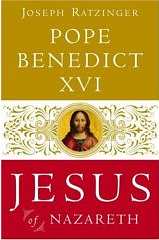
Father John Zuhlsdorf var sist fredag på en pressekonferanse i Roma, der pave Benedikts bok «Jesus fra Nasaret» – som utgis i dag, på hans fødselsdag – ble presentert. Han srkiver en lang tekst om boka, som jeg tar med noen klipp fra her. Les hele teksten her. (Boka kan forhåndsbestilles fra bl.a. Amazon i England – se her.)
The book is intended to be “pastoral”. At the same time it is to be “a rigorous work of theology”. I am not sure how the pastoral thing is going to work out: the Italian edition has 446 dense pages. And I mean conceptually dense. It is truly the work of Joseph Ratzinger. ….
He wrote the book duing the last few summers, which astonishes me, given his many cares. Clearly he gave a lot of thought to it before he wrote it. Thought and prayer, which turns out to be an important dimension of the book. Without snuffing out faith in his intellectual examination Pope Ratzinger remains an objective hunter after the Truth. So, the Pope puts himself into the modern public square, the post-Christian and post-modern areopagus. He does so as a man of rigorous intellectual discipline but also a man of faith. Faith not just in abstractions, but in a Person. … …
In the book, one of the Pope’s goals is to employ the historical-critical method of exegesis, a scientific method, which embraces its advantages and also recognizes its limitations. For example, in his preface he reminds us that the historical-critical method, as indispensible as it is, nevertheless is forced to leave the Word of God in the past only. But the Word is always in the now too, it is present. Exegetes must not fall into that trap. Ratzinger examines biblical with an eye to their completeness, which is not in contradiction with the historical-critical method, but develops it in an organic manner and turns it into theology true and properly understood.
Another relevant tangent: His Holiness has a global or “organic” vision of theological method. The same goes for liturgy. … Whether it has to do with the “source and summit” of Christian life (the Eucharist and It’s celebration), or a vision of Europe which has the indispensable structure of Christendom at its core, philosophy or theology, or explaining the relationship of faith and reason, Ratzinger does not create false divisions.
The Holy Father, as a working theologian, therefore makes use of the modern tools of scientific method, but always with logical priority given to what is known by faith in revelation. Therefore, he does not destroy the very biblical texts he so closely examines. This has been a problem of the application of the scientific method of the Scripture scholarship, that is the study that does not reduce the Bible to literature only, for many decades.
You will remember that during his Mass for Holy Thursday the Pope caused a bit of surprise by using modern research on the nature of the Last Supper. In his book, Benedict makes use of modern research on the figure of St. John the Baptist. As Pope, he demonstrates that he is willing to move outside the golden cage of pontifical precedents and Patristic glosses. …
Since Joseph Ratzinger during his long career as a theologian has not fallen into the trap of reducing the object of his contemplation to a formula or abstraction there is a chapter on prayer, in which he explains the “Our Father”, which is the prayer Christ taught us. The Pope stays very close to the Scriptural texts in every move he makes in this book. Card. Schoenborn related his personal experience of the Pope as a teacher and then colleague. He said that the Pope never was without his little Nestle-Aland edition of the New Testament in Greek.
